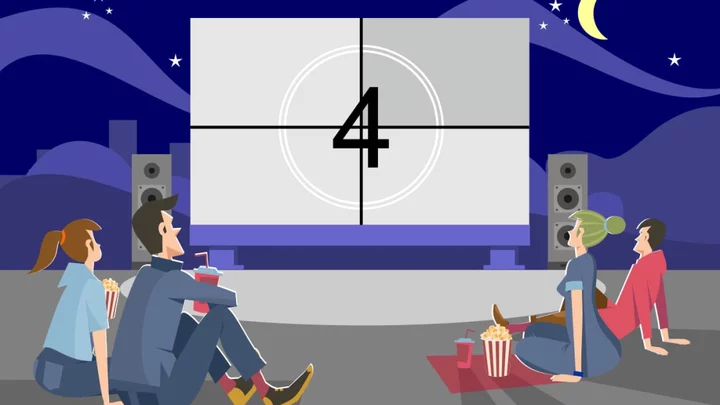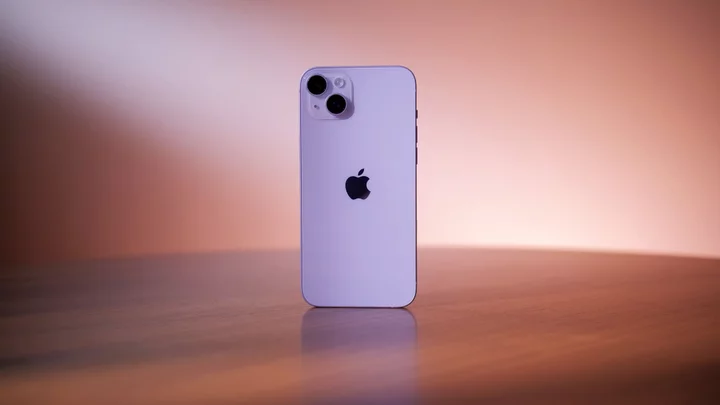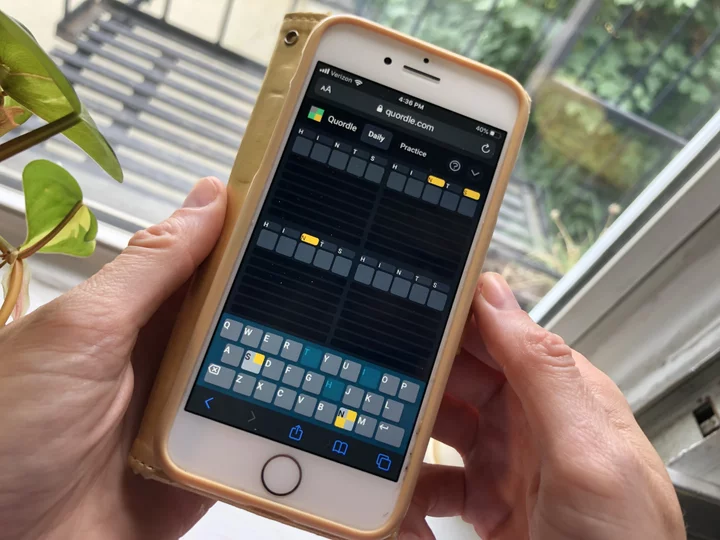Yearn to watch movies in the backyard—whether bundled up with the patio heater turned on, or enjoying balmy evening temps in spring or summer? It's easier than you might think. Virtually any projector on the planet can turn an outside wall into a cinema, but it wasn't long ago that almost none had all the right features to make it easy. Today, a growing number do.
We'll take you through our favorite tested picks for outdoor projectors, followed by a detailed buying guide to what to look for. Most of these models fall in a category we call "room-to-room portables." But what moves conveniently to another room also moves conveniently to the backyard. In addition to being light enough to carry over short distances, room-to-room portables include robust audio designed to offer both high enough volume and quality so you won't have to lug a separate sound system outside, too. They also typically have features like auto-focus to help you set up quickly, and most offer streaming, so you can skip attaching a video source, as long as you keep close enough to your house so you can connect to your network by Wi-Fi. There are even some designed particularly for outdoor use, complete with some level of water and drop resistance.
We've also thrown in a portable mini projector or two—defined in part by a smaller size and a more limited audio system. But keep in mind that you still have the option of using virtually any projector you like outdoors. Note also that the price range for these models runs starts at $299 list at this writing, but given the current inflationary pressures of our post-pandemic era, the entry cost could rise. If even $300 is more than you want to invest in a projector, take a look at our related story with tips for putting on a backyard movie night without breaking the bank.
Now that you've seen our favorite tested picks above, you might have gathered from our assessments of each that minding the nuances when shopping for a projector can mean the difference between an A-list experience and a B-movie one.
Rule one is that every projector choice you make stems from a single decision: Do you want a permanent installation or an ad hoc setup? At one extreme, you can install all your projection equipment outdoors, fixed in place and weatherproofed: projector, video source, ancillary sound system, and screen. At the other, you can lug everything out to set up only when needed. In between, you might install, say, an outdoor screen and speakers, and carry the rest of the gear out and back as needed.
For permanent setups, only the projector, the video source, and additional audio components need to be protected from the weather, and that can be easy if you have, say, an enclosed Florida room with a sliding door to the outside. With everything set up, you can just open the door to let the projector light up the screen. For anything short of permanent setup, room-to-room portables let you minimize how much you need to carry back and forth before and after every movie night. But note that you might want to store even outdoor screens inside for winter or before a storm.
(Credit: Shutterstock)If you're looking at a true, permanent outdoor installation of all the bits, we'd leave that approach to a local pro A/V installer, who can consult on your property's specific needs for optimization, and be sure all the proper power wiring and the like is implemented safely. We'll concentrate here on the DIY approach, in which you set up and break down all or most of your setup as needed.
The Projected Image: How Big Should It Be?
Brightness requirements for a given projector are no different outdoors than indoors. It's all about ambient light and the target image size (which we'll get to shortly).
The ambient-light level outdoors after dark will likely be in the range between a dark room—if you're way out in the country far from light pollution, and it's a moonless night—and a family room at night with dim lighting. But don't just assume that. Check your backyard at night, including on nights with a full moon, as well as when your closest neighbors have their backyard lights blazing. Then pick a projector that's bright enough to stand up to the brightest light level you'll use it under at the image size you want—an issue we discuss in our reviews.
(Credit: Shutterstock)You can watch a movie outdoors at night even on a pocket projector that puts out 100 lumens or less, but you'll have to huddle around a small image to watch it. If you want a true movie-watching experience, you'll want a minimum 80-inch screen size, and preferably larger.
For a comfortably watchable image at that size in dim lighting, you need a projector that puts out about 800 lumens—a level of brightness that rules out most small projectors, from pocket-size models to lightweight portable projectors.
Keep in mind, also, that the highest brightness most projectors can deliver comes at the cost of image quality. Put another way: The best-quality picture mode for any given projector is generally the dimmest. Whatever brightness you need has to be for the picture mode you want to use—which is often just 40% or 50% of the brightest choice.
The Screen: Just Use the Garage Door? (Spoiler: You Can, But Don't)
You can use just about any more-or-less flat surface for a screen, including a hanging bedsheet, a garage door, or a stucco wall of your house. Seamless photography paper and even white foam board can be good inexpensive screen materials. But for the best image, you absolutely want a dedicated projector screen, and should take a look at our tips for how to choose the right screen for your projector.
It's easy to find outdoor frames for permanent, seasonal, and temporary setups, but the screen material is the more important part. The key choices are the same as for an indoor screen, starting with a spec called gain, which can increase image brightness.
(Credit: Shutterstock)A 1.0-gain screen reflects light equally in all directions over a 180-degree viewing angle. A higher gain reflects the light over a smaller angle, making the image brighter within that angle and dimmer outside of it. It's essentially the same situation as with older LCD screens that have a sweet spot for viewing dead-on in front of them, but show degraded image quality outside of the viewing cone. For projector screens, a 1.2-gain would give you a peak 20% brighter image within the cone. The key thing is the angle, though: You'll want to make sure nobody will be sitting so far to the side of the screen that they'll be sitting outside the specified viewing angle.
If you're screen-shopping, also look for the resolution the screen is designed for. Many are not meant for showing even 4K images, while some are designed for future-looking 8K output. Even if you're using a mere 720p-resolution projector now, you might want a 4K-rated screen, so you can use the same screen over the lifetime of two or more projectors.
Finally, be sure the screen offers the right aspect ratio—typically, 16:9 for watching movies or TV shows. Common choices range from the almost square 4:3 ratio that used to be standard for TV to Cinemascope wide.
What Is Throw Distance, and Why Does It Matter?
Throw distance is measured in feet or inches between the projector lens and your screen. For any projector or projector lens, it falls into one of four categories.
As the name implies, a standard throw is the most common, needing roughly 10 feet to the screen for a 90-inch image (measured diagonally), give or take a couple of feet depending on the lens. A long throw lets you put the projector much farther away for the same size screen.
(Credit: Shutterstock)A short throw lets you position the projector closer than the range for standard throw, which is absolutely necessary in a tight space and actually helpful for a backyard-movie night. That may seem counterintuitive, but if everyone is sitting behind the projector, rather than between the projector and screen, no one can cast shadows when they stand up mid-movie to get another skewer of shrimp from the barbie.
Last, ultra short throws, or USTs, let you put the projector just inches away for the same image size. However, these are best avoided for outdoors, in part because they are finicky about being positioned "just so" relative to the screen, which adds to setup time. They also require a much flatter screen than longer throws, and a screen material with absolutely no tendency to move from a wind gust. Even a slight deviation from perfectly flat will distort the image.
Do You Need an External Audio System or Speakers for Your Outdoor Projector?
Most projectors you're likely to consider for backyard movies today have a built-in speaker or speakers. But with the exception of room-to-room portables, which offer good audio systems by definition, and the growing category of laser UST projectors that are often advertised as laser TVs (and aren't suitable for lugging to the backyard), you'll want an external audio system in most cases, or at least external speakers. The reason: It's difficult to deliver good-quality audio at high volume levels from the small spaces most projector chassis leave for the sound system.
Room-to-room portables offer extra-wide or taller, nearly cubic shapes than traditional projectors, and fill the extra space with low- and high-frequency speakers (technically, "drivers," in audio terminology), which are often chamber speakers. They usually boast plenty of wattage to provide sufficient volume even for outdoor use. (Laser UST projectors are much wider than traditional projector designs, and many use the side facing the seating area for what amounts to a soundbar.)
Of course, regardless of how good the audio quality and volume are for the projector you pick, you might want even more robust audio. If so, consider getting outdoor speakers, and look for analog or digital audio-out ports or Bluetooth speaker support in the projector. Bluetooth can be especially handy if you already own a robust Bluetooth speaker set, but with a caveat we'll get to in a moment. Many home theater projectors don't offer even a pass-through audio port, however. They're designed with the assumption that you'll use a separate audio system connected directly to your video source.
As for Bluetooth speakers: Because of the vagaries of both video and audio processing, losing sync between the image on the screen and the sound from a Bluetooth speaker is a common issue. To avoid it, look for audio-delay adjustments for Bluetooth speakers in projectors and in external audio systems. Note also that most room-to-room portables, and many smaller portables, offer a Bluetooth speaker mode themselves, so you can use them with other audio sources.
One last thing: A booming audio system might be great within the confines of your own backyard, but consider your neighbors' comfort when you set the volume. (Or make sure to skewer extra shrimp, pop extra popcorn, and invite them over.)
What Resolution Do You Need From Your Outdoor Projector? (720p, 1080p, or 4K)
Any given projector offers a native resolution, which tells you the number of pixels it can put on the screen. More pixels means finer detail. For the projectors most appropriate for movies, you have three basic choices: 720p (1,280 by 720), also called HD; 1080p (1,920 by 1,080), also called Full HD; and 4K (3,840 by 2,160), also called Ultra HD or UHD. In some cases the native resolution for the imaging chip may be slightly greater, as with 1,280 by 800, but when you're viewing a movie, the actual number of pixels that will light up will be 1,280 by 720 or fewer, depending on the movie's aspect ratio (the ratio of width to height). All three of the resolutions you care about have a 16:9 aspect ratio.
Choosing among these resolutions depends almost entirely on how big your budget is and much you care about seeing fine detail. Higher resolution costs more, shows more detail, and has a sharper look. However, resolution doesn't affect color, contrast, or any other aspect of image quality. A lower resolution just gives the image a slightly soft-focus look in comparison. Note also that most 720p and 1080p projectors can accept higher-resolution input and downconvert the image to their native resolution, so they behave like a higher-resolution projector with a soft focus. However, you might want to check the highest-resolution input a projector supports before buying.
More and more 1080p and 4K projectors also support HDR, which can do more to improve the visual impact for movies than higher resolution does. Unfortunately, the key phrase in that sentence is "can do more." Few of the projectors suitable for carrying outside for backyard movies at this writing deliver on HDR's promise of improving image quality. In fact, most put a better-looking image on the screen with the 1080p SDR versions of movies than the 4K HDR versions. So while you can count on 4K projectors giving you more detail than 1080p projectors (assuming you're using a large enough screen and watching from a close enough distance to see the difference), don't count on HDR support translating to improved image quality. Check how well the projector actually handles HDR, which is something we cover in our reviews.
What Should Be Your Outdoor Projector's Power Source: Battery, or AC?
You should plan on using AC power for all your equipment. Some small projectors (but few room-to-room portables) can run off of battery power, and some even claim to run for long enough to watch a movie. But they typically drop brightness significantly when using batteries, and most aren't bright enough for a backyard movie night at a suitably large size even using AC power. Beyond that, simply as a matter of convenience, the more individual battery-powered devices you're using, the more of a logistical chore it is to make sure each one is sufficiently charged before you start.
For safety's sake, add a professionally installed outdoor outlet near the equipment location, so you don't have to use a trip-me-up extension cord or a chain of cords and power strips. And make sure any outlet you plug into includes ground fault protection to guard against electrical hazards.
The Video Source: How Will You Send Movies to Your Outdoor Projector?
Unless you're playing movies stored on a flash card or USB drive connected to a projector that can read the files, you'll need to pipe in your video from somewhere. With most room-to-room portables, the simplest choice is usually to take advantage of the built in streaming or bundled streaming stick that virtually all models in the category offer, most often using either Android TV or Android OS. Don't confuse these two options. Android TV offers lots of capable streaming apps. Most Android OS implementations offer fewer apps, and many of the apps they offer don't work well.
Streaming over a Wi-Fi connection can be a handy way to take advantage of streaming services like Hulu or access files on your home network via an app like Plex. However, note that most projectors with Android TV either don't offer a Netflix app at all or offer one that's difficult to use. So if Netflix is your go-to streaming service, try to confirm whether there is a Netflix app, and, if so, how well it works, before you buy. If there's no app, or only a flawed app, one good workaround is to connect your phone to your network via Wi-Fi, stream using a Netflix phone app, and set up your projector to mirror your phone's screen.
(Credit: Shutterstock)For projectors that don't have built-in streaming or a bundled streaming stick, it's easy enough to add one. And if you're not happy with the streaming options that came with the projector you otherwise want (or already have), it's also easy to ignore the built-in or bundled choice and plug in a different dongle, whether that's an Amazon Fire TV Stick, a Roku Streaming Stick+, or something else. (See our guide to selecting the best media streamer.)
Almost all current home projectors offer a USB port to provide power for an HDMI dongle, typically near an HDMI port and often with no other function. You might want to check for one when choosing a projector. If you wind up with a projector without one, a robust power bank connected to a USB power cable may do if a power cord can't reach.
When you're outdoors, connecting a larger discrete video source to the projector can be a challenge. Active optical HDMI cables and HDMI extenders can let you connect over hundreds of feet, but typical HDMI cables are limited to a maximum of 25 feet, at best, and even much shorter cables often have problems providing a reliable connection for 4K HDR content. You otherwise may need to haul a Blu-ray player or laptop outside to plug into the projector.
If the projector supports Wi-Fi, and the video source can connect to your network by either Wi-Fi or Ethernet, you can connect wirelessly, of course. But for any of the video sources mentioned here to connect by Wi-Fi, including the streaming sources, you may need to add a Wi-Fi extender to your network to get a strong enough signal to your backyard. Whether you'll actually need that or not will depend on the configuration of your home and the output strength and location of your router. Another alternative: Convert your home network to a mesh system to ensure more even, complete coverage. (See our primer Wi-Fi Range Extender vs. Mesh Network: What's the Difference?)
Another possibility—which will work with any projector and video source with HDMI ports—is a wireless HDMI kit. These kits include a transmitter that plugs into the video source's HDMI output and a receiver that plugs into the projector's HDMI port, working in essence just like an HDMI cable, but without the cable.
Finally, as mentioned above, if you want to play content downloaded (legally, mind you) to a USB drive or flash-memory card, make sure to pick a projector with an appropriate card slot or USB port. One wrinkle to that: Verify that the projector not only supports playing movies from the memory card or key, but supports playing them at the target resolution you want to use. That's not always a given.
So, Which Outdoor Projector Should You Get?
In our summaries above and in the spec table below, we've chosen some of the best projectors on the market for specific outdoor-projection situations and usage cases. For more projector reviews and our latest coverage of the category, check out our projector-coverage summary page, as well as our top picks for home projectors.









